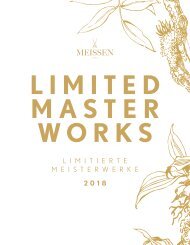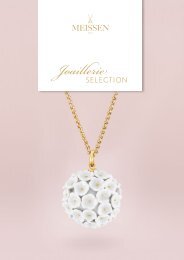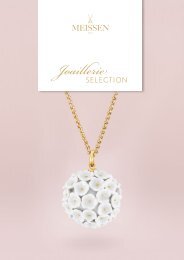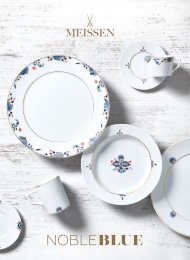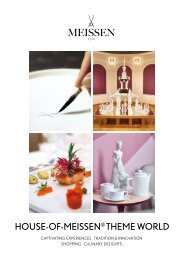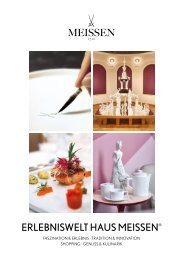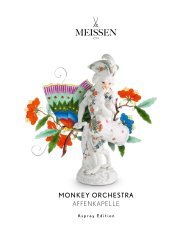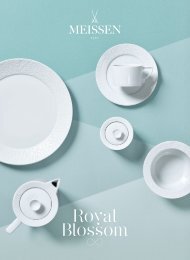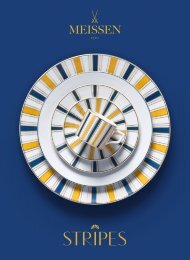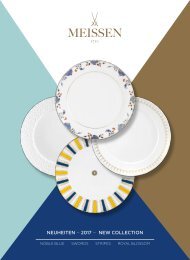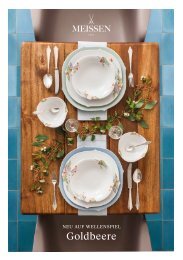MEISSEN Limited Edition 2018
Sie wollen auch ein ePaper? Erhöhen Sie die Reichweite Ihrer Titel.
YUMPU macht aus Druck-PDFs automatisch weboptimierte ePaper, die Google liebt.
l i m i t e d e d i t i o n<br />
<strong>2018</strong>
4 Ei n fü h ru n g introduction<br />
L i m i t e d E d i t i o n<br />
L i m i t e d E d i t i o n<br />
Mit der neuen „<strong>Limited</strong> <strong>Edition</strong>“ stellen wir eine besondere<br />
Jahres-<strong>Edition</strong> vor, die kleinere, aber ganz besondere Sammler stücke<br />
umfasst. Inspiriert ist sie vom großen Erbe der Manufaktur und dem<br />
reichen Fundus an Formen und Farben. Wenn dieser historische Schatz<br />
auf die Leidenschaft der Meissener Manufakturisten trifft, entstehen<br />
immer wieder neue, bezaubernde Kreationen.<br />
Unsere „<strong>Limited</strong> <strong>Edition</strong>“ ist durch die Limitierung der Stücke von<br />
besonderem Wert. Bedeutender ist aber wohl das Glücksgefühl, das unser<br />
Meissener Porzellan ® auslösen kann. Lassen Sie sich infizieren<br />
und genießen Sie eine Reise durch die große Geschichte der Manufaktur<br />
Meissen, neu interpretiert und mit Liebe zum Detail umgesetzt.<br />
We are launching a new annual series with our “<strong>Limited</strong> <strong>Edition</strong>” that<br />
focuses on smaller but nevertheless very special collectible items. It draws<br />
on the Manufactory’s great legacy and rich stocks of shapes and colours.<br />
New creations invariably materialise whenever this historical treasure store<br />
and the passion of the Meissen Manufactory staff are brought together.<br />
Our “<strong>Limited</strong> <strong>Edition</strong>” is of particular value owing to the limited number of<br />
copies there are of a piece. Surely of greater significance, however, is the<br />
sense of joy that our Meissen porcelain ® can set free in us. Reason<br />
enough, then, to catch the bug and tour the Meissen Manufactory’s illustrious<br />
history, reinterpreted and implemented with loving attention to detail.
5
6
Han dwerksku n st<br />
Craftsmanship<br />
7<br />
U n e n d l i c h e L i e b e<br />
i n P o r z e l l a n<br />
E v e r l a s t i n g l o v e i n p o r c e l a i n<br />
Wi e e n t s t e h t e i g e n t l i c h e i n S t ü c k d e r „ L i m i t e d Ed i t i o n “ ?<br />
M i t v i e l H e r z b l u t , H i n g a b e u n d H a n d we r k s k u n s t …<br />
How does any “<strong>Limited</strong> <strong>Edition</strong>” item take shape? With no end<br />
of commitment, dedication and craft skills …<br />
2<br />
V o r l a g e N<br />
S o u r c e s<br />
1<br />
K a o l i n<br />
K a o l i n<br />
Die Porzellanerde – das Kaolin – ist der Grundstoff,<br />
aus dem das <strong>MEISSEN</strong>ER PORZELLAN ®<br />
besteht. Zutage gefördert wird es im kleinsten<br />
Bergwerk Deutschlands in Seilitz nahe Meißen,<br />
seit 1814 exklusiv für die Porzellan-Manufaktur.<br />
Das eigene Kaolin ist ein besonderer Rohstoff,<br />
der außergewöhnlich weiß brennend ist, was das<br />
<strong>MEISSEN</strong>ER PORZELLAN ® so besonders macht.<br />
China clay – kaolin – is the most essential<br />
ingredient in <strong>MEISSEN</strong> PORCELAIN ® . It has<br />
been extracted since 1814 from the smallest mine<br />
in Germany at Seilitz near Meissen exclusively<br />
for the Porcelain Manufactory. The company’s<br />
own kaolin is a select raw material that fires to an<br />
extraordinary whiteness, and it is this that makes<br />
<strong>MEISSEN</strong> PORCELAIN ® so special.<br />
Kupferstiche, Aquarelle, Skizzen, Bücher,<br />
historische Porzellane: Das <strong>MEISSEN</strong> ® -Archiv<br />
verfügt über eine Vielzahl an Werken, die<br />
seit Gründung der Manufaktur beschafft und<br />
gesammelt wurden. Sie dienten und dienen als<br />
Inspirationen und Vorlagen für Dekore. Das<br />
Formenarchiv versammelt gar rund 24.000<br />
einzelne Formenvorlagen – entstanden in mehr<br />
als 300 Jahren Manufakturgeschichte.<br />
Etchings, watercolours, sketches, books, historical<br />
porcelains: the <strong>MEISSEN</strong> ® archives hold a wealth<br />
of work procured and collected ever since the<br />
Manufactory was founded. They have always<br />
served as inspiration and source material for<br />
patterns. The Archive of Moulds contains some<br />
24,000 separate source moulds produced in<br />
more than 300 years of Manufactory activity.
8<br />
Han dwerksku n st<br />
Craftsmanship<br />
4<br />
B o s s i e r e n<br />
R e p a i r i n g<br />
3<br />
F o r m e n h e r s t e l l u n g<br />
M o u l D - M a k i n g<br />
Im Formenbau der Manufaktur entstehen auf<br />
Basis der archivierten Modelle Arbeitsformen.<br />
Zuerst werden Tonmodelle gefertigt und bearbeitet,<br />
anschließend werden davon Arbeitsformen<br />
aus Gips abgenommen. Figuren sind<br />
in Einzelteile aufgegliedert, jedes dieser Teile<br />
erhält eine eigene Form.<br />
Working moulds are produced in the Manufactory<br />
mould shop on the basis of the archived<br />
originals. Clay models are first cast and tidied<br />
up before being used to form working moulds<br />
in plaster of Paris. Figures are made up of<br />
several individual parts, all of which are moulded<br />
separately.<br />
5<br />
Die Modellierung mit Porzellan, „Bossieren“<br />
genannt, ist Kunsthandwerk auf höchstem<br />
Niveau. Der Bossierer setzt zum Beispiel<br />
Figuren aus Einzelteilen mit Porzellanschlicker<br />
zusammen, arbeitet jedes mit speziellen<br />
Modellierwerkzeugen aus, beseitigt Nähte und<br />
ergänzt Details in der Oberflächenstruktur.<br />
Zusätzliche Schmuckelemente modelliert er<br />
mit kleinen Ausformhilfen oder frei von Hand.<br />
The process of completing a model in porcelain,<br />
known as “repairing”, is craftsmanship of the<br />
highest order. The repairer composes figures by<br />
luting the various parts together with porcelain<br />
slip, sharpening each of them with dedicated<br />
modelling tools, removing mould seams and<br />
bringing out the surface texture. They model<br />
additional decorative features either using tiny<br />
press moulds or freehand.<br />
B r e n n e n<br />
F i r i n g<br />
Der erste Brand des Porzellans heißt „Glühbrand“, und<br />
er entzieht bei 900° C der Porzellanmasse das Wasser.<br />
Dadurch schrumpft die Form, und das Stück bekommt<br />
vorerst eine raue, spröde Oberfläche. Haben Formenbauer<br />
oder Bossierer einen Fehler gemacht, kommt er<br />
bereits hier ans Licht: Entstehen Risse oder Verformungen,<br />
muss die Arbeit noch einmal von vorn beginnen.<br />
Porcelain first undergoes what is known as “biscuit firing”<br />
at 900 °C, during which water is removed from the porcelain<br />
body. This causes the piece to contract and acquire<br />
an initially coarse, rough texture. Any mistake made by the<br />
mould makers or repairers will become apparent at this<br />
stage: if any cracking or deformation occurs, the entire<br />
process has to be repeated.
9<br />
7M a l e n<br />
P a i n t i n g<br />
6<br />
G l a s i e r e n<br />
g l a z I N G<br />
Die Glasur und der anschließende Glasurbrand<br />
bei bis zu 1400° C geben dem<br />
<strong>MEISSEN</strong>ER PORZELLAN ® seine seidigglatte<br />
und hochweiße Oberfläche, für die es<br />
so berühmt ist. Die Glasur schützt auch das<br />
Marken zeichen von <strong>MEISSEN</strong> ® : die kobaltblauen<br />
Schwerter, die auf dem Boden eines<br />
jeden Stückes von Hand verewigt werden.<br />
It is the glaze and subsequent glost firing at up to<br />
1400 °C that gives <strong>MEISSEN</strong> PORCELAIN ®<br />
the silky smooth, intensely white finish for which<br />
it is so famous. The glaze also protects the<br />
<strong>MEISSEN</strong> ® trademark: the cobalt blue swords<br />
immortalised by hand on the bottom of each<br />
piece.<br />
Ob Vogel-, Blumen-, Putten- oder Porträtmalerei: Für<br />
fast jedes Sujet und jede Stilrichtung gibt es eigens<br />
ausgebildete Porzellanmaler in der Manufaktur, die<br />
wahre Meister ihres Faches sind und mit viel Kreativität<br />
und Hingabe Dekore entwickeln oder Figuren mit Farbe<br />
Leben einhauchen. Gleichzeitig müssen sie auch jede<br />
Menge Erfahrung besitzen: Viele der Porzellanfarben<br />
zeigen ihren wahren Farbton erst nach dem Brand.<br />
Be it bird, flower, cherub or portrait painting, there are specially<br />
trained porcelain painters for almost every subject and<br />
artistic style at the Manufactory who are true masters of their<br />
trade and who, with great creativity and dedication, develop<br />
patterns or use colour to breathe life into figures. They also<br />
need to be very experienced: many porcelain paints only<br />
acquire their intended colour once they have been fired.<br />
8<br />
B r e n n e n<br />
F i r i n g<br />
Nach der Bemalung – oftmals auch mehrfach, je nach Farbkombinationen des<br />
Dekors – wird das Stück nochmals gebrannt. Die Porzellanfarben, bis dahin<br />
eher stumpf, verschmelzen dabei mit der Glasur und zeigen nun ihre echten,<br />
strahlenden Farbtöne, die Porzellanliebhaber so schätzen und die die Stücke<br />
der „<strong>Limited</strong> <strong>Edition</strong>“ zu einem einzigartigen Blickfang machen.<br />
Once a piece has been painted, it is returned to the kiln – several times in many<br />
cases, depending on the mix of colours in the pattern. The hitherto rather dull<br />
porcelain paints fuse with the glaze and, in so doing, assume the brilliant hues<br />
so beloved of porcelain enthusiasts that transform “<strong>Limited</strong> <strong>Edition</strong>” items into<br />
unique eye-catchers.
10 Werke objects<br />
E i d e c h s e n v a s e<br />
„ B l a u e r K r a n i c h “<br />
L i z a r d v a s e w i t h “ B l u e C r a n e ”<br />
Modell / Model: um 1725 / c. 1725<br />
Malerei / Painting: Ulrich Mehner<br />
Eine Eidechse hat sich aus kunstvoll gemalten Blüten und<br />
Zweigen hervorgewagt und gibt der flaschenförmigen<br />
Deckelvase ihren exotischen Touch. Form und Dekor,<br />
beide chinesisch inspiriert, gehören seit etwa 1725 zum<br />
Sortiment von <strong>MEISSEN</strong> ® . Bereits damals beherrschte<br />
die Manufaktur die hohe Kunst, reinweißes Porzellan zu<br />
fertigen, das die konturscharfe, kobaltblaue Bemalung<br />
erstrahlen lässt. 1726 wurden acht dieser kostbaren<br />
„Kaminaufsatzstücke belegt mit Eidechse“ an die<br />
königliche Sammlung Augusts des Starken ausgeliefert.<br />
Über der Echse, die laut chinesischer Mythologie<br />
Geborgenheit, Licht und Wärme ins Leben bringt,<br />
schwingen sich heute statt Blumen Kraniche in die Luft.<br />
Als Himmelsboten und Glücksbringer steuern die<br />
stolzen Vögel das Übrige dazu bei: Welch ein Glück, so<br />
ein königliches Kunstwerk zu besitzen.<br />
A lizard has ventured out from amongst consummately<br />
painted flowers and sprigs to lend an exotic touch to this<br />
bottle-shaped covered vase. Its shape and pattern, both<br />
Chinese-inspired, have been in the <strong>MEISSEN</strong> ® repertoire<br />
since around 1725. Even then, the Manufactory mastered<br />
the exalted art of producing pure white porcelain that<br />
really lets the crisply outlined cobalt blue painting shine<br />
forth. Eight of these sumptuous “mantelpiece garniture<br />
items with applied lizard” were delivered to the royal<br />
collection of Augustus the Strong in 1726. In this edition,<br />
the area above the lizard, which Chinese mythology sees<br />
as bringing protection, light and warmth into our lives, is<br />
filled not by flowers but by hovering cranes. The proud<br />
birds make their own contribution as celestial emissaries<br />
and bringers of luck. And what a stroke of luck it is to<br />
own such a majestic work of art!<br />
LIM. 50<br />
Eidechsenvase „Blauer Kranich“<br />
818274-51322-1 | H 24 cm<br />
Lizard vase with “Blue Crane”
11
12 Werke objects<br />
LIM. 25<br />
Vase „Stilisierte Blattfarne“ Vase with “Stylised Fern Fronds”<br />
619274-50334-1 | H 30,5 cm
13<br />
V a s e „ S t i l i s i e r t e B l a t t f a r n e “<br />
Va s e w i t h “ S t y l i s e d F e r n F r o n d s ”<br />
Modell / Model: Sabine Wachs, 2000<br />
Malerei / Painting: Andreas Her ten<br />
Die Harmonie der Gegensätze verleiht dieser Vase ihren<br />
außergewöhnlichen Reiz. Blattfarne inspirierten die<br />
Meissener Künstlerin Sabine Wachs zu einer Form, die in<br />
ihrer Schlichtheit zugleich asiatischen Purismus und<br />
archaische Kraft ausstrahlt. Inspiriert von der leichten,<br />
beschwingten Malweise des Künstlers Willi Münch-Khe<br />
(1885–1960), der für <strong>MEISSEN</strong> ® etliche Plastiken,<br />
Formen und Dekore schuf, akzentuiert Porzellanmaler<br />
Andreas Herten die kantige Form mit weichen<br />
Rundungen. Die Rispe eines Silberblatts mit durchscheinenden<br />
Samenhüllen stand für seine fantasievolle Ranke<br />
Pate, die an den Jugendstil erinnert. Schon der sichere<br />
Schwung, mit dem sie aufs Porzellan gesetzt ist, beweist<br />
höchstes Talent und viel Erfahrung. Zartes Dekor und<br />
kraftvolle Form: ein perfektes Paar.<br />
It is the union of opposites that makes this vase so<br />
uncommonly appealing. Leafy ferns inspired <strong>MEISSEN</strong> ®<br />
artist Sabine Wachs to conceive a sober shape that<br />
exudes both Asian purism and an archaic force. Taking<br />
his cue from the breezily flowing style of painting of the<br />
artist Willi Münch-Khe (1885–1960), who created<br />
countless figures, shapes and patterns for <strong>MEISSEN</strong> ® ,<br />
porcelain painter Andreas Herten accentuates the vase’s<br />
angularity with lambent curvature. His fanciful tendril was<br />
suggested by a panicle of honesty with translucent seed<br />
capsules and has overtones of art nouveau. The fluid<br />
assurance with which it has been rendered on the<br />
porcelain is an indication of supreme talent and great<br />
experience. A softly spoken pattern and bold shape<br />
complement each other to perfection.
14<br />
Werke<br />
objects<br />
S c h r e i b z e u g m i t A m o r<br />
W r i t i n g s e t w i t h c u p i d<br />
Modell / Model: Paul Helmig, 1 903<br />
In den Zeiten, als man Gedanken, gute Wünsche und<br />
Liebesbriefe noch formvollendet mit Feder und Tinte zu<br />
Papier brachte, waren Schreibtisch-Accessoires kleine<br />
Kunstwerke. In typischer Jugendstilmanier ist das<br />
schwungvolle Schalenpaar mit einem kleinen Amor<br />
modelliert, der Schmetterlinge auf einer Blüte<br />
beobachtet. Mit der Darstellung des Knaben als Amor<br />
zitiert der Künstler Paul Helmig (1859–1939) die<br />
Glanzzeit <strong>MEISSEN</strong> ® s im Rokoko. Seinen Pfeil hält Amor<br />
hinter dem Rücken versteckt. Das Schmetterlingspaar hat<br />
sich längst auf der rosa Rose, dem Symbol der zarten<br />
Liebe, gefunden. Verspielt und ein wenig romantisch<br />
verweist das in feinsten Tönen kunstvoll staffierte Gefäß<br />
auf das Wesentliche im Leben. Ob als Schmuckstück von<br />
Schreibtisch, festlicher Tafel oder Vitrine: Es ist eine kleine<br />
Liebeserklärung – auch an die große Porzellankunst.<br />
Back in the days when thoughts, good wishes and love<br />
letters were still impeccably committed to paper by hand<br />
using a quill and ink, writing-desk accoutrements were<br />
precious works of art. This spirited double shell has been<br />
modelled in typical art nouveau manner with a small<br />
cupid observing butterflies on a flower. In portraying the<br />
lad as a cupid, the artist Paul Helmig (1859–1939) is<br />
citing the golden Rococo period at <strong>MEISSEN</strong> ® . Cupid is<br />
hiding his arrow behind his back. The two butterflies have<br />
long since settled on the pink rose, symbol of tender love.<br />
Consummately decorated in the finest of shades, this<br />
receptacle makes playful and somewhat romantic<br />
reference to the very essence of life. Whether it adorns a<br />
writing desk, ceremonious dining table or cabinet, it is<br />
indeed something of a declaration of love – one that also<br />
applies to great porcelain art.<br />
LIM. 50<br />
Schreibzeug mit Amor Writing set with cupid<br />
900374-73M20-1 | 13 x 26 cm
15
16 Werke objects
17<br />
F i g u r „ H a r l e k i n k i n d “<br />
I n f a n t H a r l e q u i n f i g u r i n e<br />
Künstler / Ar tist: Jörg Danielczyk, 20 17<br />
Malerei / Painting: Mathias Scholz<br />
Arlecchino, Colombina oder Pulcinella haben als Figuren<br />
der italienischen Commedia dell’Arte unsterblichen<br />
Ruhm erlangt, vor allem bei <strong>MEISSEN</strong> ® . Zu allen Zeiten<br />
der Manufaktur haben sich Porzellankünstler wie<br />
Kaendler und Eberlein von den Charakteren und<br />
Kostümen, die das fahrende Künstlervolk komödiantisch<br />
zum Besten gab, inspirieren lassen. Chefplastiker Jörg<br />
Danielczyk hat sie ins Heute versetzt, abstrakt aufs<br />
Wesentliche konzentriert. Erst in der Fantasie der<br />
Betrachter erwachen sie zum Leben. Die in der Form<br />
skizzierten Bewegungen und im Dekor angedeuteten<br />
Kostüme ergeben ein Gesamtbild voller Bewegung.<br />
Seine Figuren scheinen die materialgegebene Erstarrung<br />
zu überwinden. Im Jahr 2006 schuf Jörg Danielczyk<br />
bereits ein modernes Harlekinpaar. Jetzt hat es<br />
Nachwuchs bekommen – als Abschiedsgeschenk des<br />
Künstlers an seine Sammler.<br />
The likes of Arlecchino, Columbine and Pulcinella<br />
attained immortal fame as characters from the Italian<br />
Commedia dell’Arte, most notably at <strong>MEISSEN</strong> ® .<br />
Throughout the Manufactory’s existence, porcelain artists<br />
such as Kaendler and Eberlein have drawn inspiration<br />
from the roles these travelling troupes acted with such<br />
zest and the costumes they wore. Modeller-in-Chief Jörg<br />
Danielczyk has now transported them into the present, in<br />
the process abstractly focusing on their essence. They<br />
are only brought to life by the beholder’s imagination. The<br />
movements intimated by their shape and the costumes<br />
inferred by their decoration yield an overall image replete<br />
with motion. His figures seem to transcend the inherent<br />
inertia of their host material. Jörg Danielczyk has already<br />
created one modern Harlequin couple, that was back in<br />
2006. They have now been added to – as a farewell gift<br />
by the artist to his collectors.<br />
LIM. 75<br />
Figur „Harlekinkind“ Infant Harlequin figurine<br />
900374-73713-1 | H 18 cm
18<br />
Werke<br />
objects<br />
B ü s t e „ B u t t e r f l y “<br />
“ B u t t e r f l y ” b u s t<br />
Modell / Model: Jörg Danielczyk, 2000<br />
Malerei / Painting: Annett Lorenz<br />
Die Mode: In allen Epochen der figürlichen Porzellanplastik<br />
– vom Rokoko über das Biedermeier bis zum<br />
Jugendstil – ist sie ein beliebtes Sujet Meissener Künstler.<br />
Auch Chefplastiker Jörg Danielczyk variiert dieses<br />
Thema immer aufs Neue, angeregt von seinen Besuchen<br />
in Paris, dem Mekka der Haute Couture. „Butterfly“<br />
nannte er seine neueste Mode-Ikone. Egal, wie man sie<br />
dreht und wendet, bemerkte Porzellanmalerin Annett<br />
Lorenz, sie erinnert an einen flatternden Schmetterling.<br />
Ihr kostbares Dekor aus edelstem Platin spielt mit<br />
Nacktheit und Verkleidung. Im Profil zeigt die Büste<br />
einerseits ihre schillernde Seite, andererseits das, was<br />
sich hinter der modischen Hülle verbirgt: das pure<br />
Porzellan in perfekter Schönheit.<br />
Fashion has been a popular theme for Meissen ® artists<br />
in all eras of porcelain figure sculpture – from rococo to<br />
Biedermeier to art nouveau. Modeller-in-Chief Jörg<br />
Danielczyk, too, is constantly coming up with fresh<br />
variations on this theme, stimulated by his visits to Paris,<br />
that mecca of haute couture. “Butterfly” is the name he<br />
has given to his latest fashion icon. It resembles a<br />
fluttering butterfly whichever way you look at it, as<br />
porcelain painter Annett Lorenz observes. Its sumptuous<br />
decoration in finest platinum likewise juggles with<br />
nakedness and disguise. The bust shows its glittering side<br />
in profile whilst also revealing what is concealed within its<br />
fashionable shell – pure porcelain of a beauty most<br />
immaculate.
19<br />
LIM. 50<br />
Büste „Butterfly“ “Butterfly” bust<br />
90A474-73479-1 | H 28 cm
20 Werke objects<br />
LIM. 50<br />
Wandbild „Paarweise“ “Pairwise” wall picture<br />
935874-9M571-1 | 21,5 x 35 cm
21<br />
W a n d b i l d „ P a a r w e i s e “<br />
“ P a i r w i s e ” w a l l p i c t u r e<br />
Entwur f / Design: Prof. Heinz Werner<br />
Eine Liebesgeschichte als Geschenk im Jahr seines<br />
90. Geburtstages: Professor Heinz Werner versteht es<br />
noch immer meisterhaft, uns mit seinen Kunstwerken zu<br />
verzaubern. Mit scharfem Blick fängt er Details ein, die er<br />
mit schnellem, leichtem Strich auf seinem Skizzenblock<br />
festhält, um sie später voll lebhafter Ausdruckskraft auf<br />
seinem Lieblingsmalgrund Porzellan verewigen zu lassen.<br />
Seine zahlreichen Bilder und mehr als 100 Dekore, die er<br />
in über 50-jähriger Tätigkeit für <strong>MEISSEN</strong> ® geschaffen<br />
hat, leben von solchen Momentaufnahmen. Mit der<br />
Feder gemalt und nur leicht koloriert, genügen drei<br />
kleine Szenen, um zu zeigen, wie zwei Menschen ihre<br />
Zuneigung füreinander entdecken: Eine zufällige<br />
Begegnung, ein kurzer Blick, und aus zarten Gefühlen<br />
wird großes Begehren – eine Liebe, die auf dem<br />
kostbaren Porzellan nie verblassen wird.<br />
A love story as a gift in the year he turns 90: Professor<br />
Heinz Werner still has an utter capacity for bewitching us<br />
with his art. He has a fine eye for detail, recording what<br />
he sees with deft rapid strokes on his sketchpad and<br />
immortalising it with vibrant powers of expression on<br />
porcelain, his favourite painting surface. The numerous<br />
pictures and hundred-plus patterns he has authored<br />
during his more than 50-year career at <strong>MEISSEN</strong> ® were<br />
all fuelled by such momentary impressions. Drawn with a<br />
pen and only lightly coloured in, three little scenes suffice<br />
to show how two people discover their fondness for one<br />
another: a chance encounter, a brief exchange of glances<br />
and tender feelings are already making way for deep<br />
longing – a love that, on precious porcelain, will never fade.
22<br />
Werke<br />
objects<br />
W a n d g e m ä l d e<br />
„ S t i l l l e b e n m i t K i r s c h e n “<br />
“ S t i l l L i f e w i t h C h e r r i e s ”<br />
w a l l p a i n t i n g<br />
Malerei / Painting: Sarah Helm<br />
Fast fotorealistisch lenkt das Stillleben den Blick auf die<br />
zum Anbeißen appetitlichen Kirschen. Das Spiel von<br />
Licht und Schatten verleiht den Früchten eine besonders<br />
natürliche, plastische Wirkung. Die Meissener Künstlerin<br />
Sarah Helm nutzt für ihre Darstellung eine besondere<br />
Inglasurfarbe, die separat auf das Porzellan gemalt und<br />
gebrannt wird. So erhalten die Kirschen ihr intensives<br />
Rot. Erst danach werden in mehreren Schichten<br />
Aufglasurfarben appliziert. Mit dieser hochkarätigen<br />
Porzellanmalerei gelingt es Sarah Helm, dem Motiv aus<br />
einem historischen Ölgemälde der deutschen Malerin<br />
Clara von Sivers (1854–1924) auf Porzellan eine<br />
besondere Tiefe zu verleihen. Blüte und Früchte<br />
erscheinen so echt, dass man zugreifen möchte – große<br />
Kunst im Kleinformat.<br />
The way this still life draws our attention towards cherries<br />
that look tasty enough to bite into is akin to photorealism.<br />
The play of light and shade causes the fruit to look<br />
particularly natural and three-dimensional. <strong>MEISSEN</strong> ®<br />
artist Sarah Helm uses a special inglaze paint for her<br />
rendition that is applied to the porcelain and fired<br />
separately. This is what gives the cherries their intense red<br />
colour. Only then are overglaze colours painted on in<br />
several layers. Adopting such a sophisticated style of<br />
painting enables Sarah Helm to lend the motif from a<br />
historical oil painting by the German artist Clara von<br />
Sivers (1854–1924) impressive depth on porcelain. The<br />
flower-head and fruit look real enough to take hold of –<br />
great art in a small format.
23<br />
LIM. 25<br />
Wandgemälde „Stillleben mit Kirschen“<br />
932A74-9M502-1 | 25 x 25 cm<br />
“Still Life with Cherries” wall painting
24 Werke objects
25<br />
D o s e n m i t S c h e u r i c h - D e c k e l<br />
B o x e s w i t h S c h e u r i c h c o v e r s<br />
Modell / Model: Paul Scheurich<br />
Malerei / Painting: Annett Lorenz<br />
Von der Welt des Theaters fasziniert, variierte der<br />
Porzellankünstler Paul Scheurich (1883–1945) immer<br />
wieder Themen wie Maskerade und Tanz, Galanterie und<br />
Groteske. Mit den Modellen, die er zwischen 1913 und<br />
1937 für <strong>MEISSEN</strong> ® schuf, knüpfte er an die klassische<br />
Figurenwelt des Meissener Rokoko an. Ganz im Zeitgeist<br />
der 1920er-Jahre gelang es ihm, dem Porzellan eine<br />
mondäne, sinnlich-elegante Ausstrahlung zu verleihen.<br />
Mehr als 70 Jahre nach seinem Tod bereichern nun zwei<br />
neue Werke das Œuvre des Ausnahmekünstlers:<br />
Bonbonnieren mit Maskenköpfen. Lange Jahre waren die<br />
Gipsmodelle aus seinem Nachlass im Besitz eines<br />
Sammlers verborgen. Bei <strong>MEISSEN</strong> ® wurden die<br />
Schätze jetzt erstmals ausgeformt und kunstvoll<br />
zurückhaltend im Sinne Scheurichs so dekoriert, dass sie<br />
mit bewussten Akzenten das Auge aufs Wesentliche<br />
lenken – kleine Meisterwerke eines großen Künstlers.<br />
The porcelain artist Paul Scheurich (1883–1945) was so<br />
captivated by the world of theatre that he produced<br />
constant variations on themes such as masquerade,<br />
dance, gallantry and the grotesque. The models he<br />
created for <strong>MEISSEN</strong> ® between 1913 and 1937 drew on<br />
the classic figural world of <strong>MEISSEN</strong> ® rococo. He<br />
managed to imbue porcelain with an urbane, sensuously<br />
elegant quality wholly in keeping with the spirit of the<br />
1920s. More than 70 years after his death, the oeuvre of<br />
this outstanding artist has been discovered to include two<br />
hitherto overlooked works – bonbonnières with mask<br />
heads. The plaster models he bequeathed had long<br />
languished in the holdings of a collector. The treasures<br />
have now been cast for the first time at <strong>MEISSEN</strong> ® and<br />
decorated with consummate constraint in the Scheurich<br />
vein, focus detail consciously guiding the eye towards the<br />
essence – small masterpieces by a great artist.<br />
LIM. 100<br />
Dose „Die Maske“ “Mask” box<br />
90A374-52114-1 | H 7,5 cm<br />
Dose „Der Harlekinkopf“ “Harlequin’s Head” box<br />
90A574-52115-1 | H 10,5 cm
26<br />
Werke<br />
objects<br />
S o n n e n b l u m e n b l a t t<br />
“ S u n f l o w e r L e a f ” d i s h<br />
Modell / Model: um 1760 / c. 1760<br />
Malerei / Painting: Beate Jach<br />
Als kühner Stratege mit Sinn für Musik und Kunst ist der<br />
preußische König Friedrich der Große (1712–1786)<br />
bekannt – und als Liebhaber des „Weißen Goldes“. So<br />
gab er während seiner Besetzung Sachsens im<br />
Siebenjährigen Krieg (1756–1763) bei <strong>MEISSEN</strong> ® ein<br />
großes Tafelservice in Auftrag. Als Blüten, Früchte und<br />
Blätter modelliert, faszinieren vor allem die kleinen<br />
Konfektschalen mit großer Porzellankunst. Bis in die<br />
feinsten Strukturen sind die Blüten und die vom Henkel<br />
verbundenen Blätter handmodelliert. Die zart von den<br />
Rändern zur Blattmitte hin verlaufende Staffage verleiht<br />
der Sonnenblume eine Natürlichkeit, die Biene, Käfer<br />
und Falter anzulocken scheint. Erst auf den zweiten Blick<br />
entpuppen sich die drei als feinste Porzellanmalerei nach<br />
Vorlagen der berühmten Insektenkundlerin Maria Sibylla<br />
Merian (1647–1717) – und machen den Zauber des<br />
kostbaren Porzellanstücks perfekt.<br />
The Prussian King Frederick the Great (1712–1786) was<br />
renowned as a bold strategist with a soft spot for music<br />
and art – and as a lover of White Gold ® . When he<br />
occupied Saxony during the Seven Year’s War (1756–<br />
1763), for instance, he commissioned a large tableware<br />
service from <strong>MEISSEN</strong> ® . The little sweetmeat dishes<br />
modelled as flowers, fruit and leaves are particularly<br />
captivating examples of great porcelain art. The flowers<br />
and the leaves connected by the handle are hand-modelled<br />
to a most intricate degree of structuring. The delicate<br />
colour running from rim to centre adds such a natural<br />
touch to the sunflower that it appears to be attracting bees,<br />
beetles and moths. It takes a second glance to realise the<br />
three have been most exquisitely painted onto the<br />
porcelain in the manner of the famous entomologist Maria<br />
Sibylla Merian (1647–1717), thus further enhancing the<br />
magic of this sumptuous piece of porcelain.
27<br />
LIM. 50<br />
Sonnenblumenblatt “Sunflower Leaf” dish<br />
20A774-53266-1 | Ø 24 cm
28 Werke objects
29<br />
G o t z k o w s k y - K a f f e e b e c h e r<br />
„ I t a l i e n i s c h e K o m ö d i e “<br />
G o t z k o w s k y “ C o m m e d i a<br />
d e l l ’A r t e ” c o f f e e m u g s<br />
Modell / Model: nach 1750 / post-1750<br />
Malerei / Painting: Beate Neßler<br />
Der spielerische Charme der Commedia dell’Arte, in der<br />
Figuren des Volkes die Oberschicht verunglimpfen, hat<br />
die Meissener Porzellankunst zu allen Zeiten inspiriert.<br />
Einst in Venedig und Neapel zu Hause, machte das<br />
fahrende Volk das Spiel zum beliebten Spektakel an<br />
barocken Höfen. Kostüme, Masken und Charaktere<br />
faszinieren die Meissener Künstler bis heute. Mit feinsten<br />
Pinselstrichen, die großes Talent und viel Erfahrung voraussetzen,<br />
lässt Beate Neßler zwei Komödiantenpaare,<br />
Narcisino und La Ballerina sowie Farbarino und La<br />
Cantatrice, vor der goldenen Kulisse Venedigs wieder<br />
aufleben. Umrahmt von 23-karätigem Gold bilden sie ein<br />
treffliches Dekor für Becher aus dem Service, das 1741 für<br />
den Berliner Kaufmann Johann Ernst Gotzkowsky<br />
(1710–1775) entworfen wurde. Als Hoflieferant des<br />
Preußenkönigs Friedrich des Großen (1712–1786) frönte<br />
auch er der Leidenschaft für Porzellan und schöne Künste<br />
– sehr zur Freude der Liebhaber und Sammler von heute.<br />
The impish charm of the Commedia dell’Arte, in which<br />
characters from the lower echelons of society mock the<br />
upper classes, has always been a source of inspiration for<br />
Meissen ® porcelain art. Emanating from Venice and<br />
Naples, the stage acts of these travelling troupes became<br />
popular spectacles at the baroque court. The costumes,<br />
masks and protagonists involved still captivate Meissen ®<br />
artists today. Beate Nessler shows talent and great<br />
experience in the way she intricately brushes new life into<br />
two commedia couples, Narcisino with La Ballerina and<br />
Farbarino with La Cantatrice, against a golden Venetian<br />
backdrop. Framed by 23-carat gold, this is a fitting<br />
pattern for mugs from the service designed in 1741 for the<br />
Berlin merchant Johann Ernst Gotzkowsky (1710–1775).<br />
As supplier to the court of the Prussian King Frederick<br />
the Great (1712–1786), he, too, indulged his passion for<br />
porcelain and beautiful art – much to the delight of<br />
today’s enthusiasts and collectors.<br />
LIM. 50<br />
Kaffeebecher coffee mug<br />
„Narcisino und La Ballerina“<br />
29A274-55310-1 | V 0,25 l<br />
Kaffeebecher coffee mug<br />
„Farbarino und La Cantatrice“<br />
29A374-55310-1 | V 0,25 l
30 Werke objects<br />
S c h a l e „ J a p a n i s c h e B l u m e n -<br />
u n d F e l d o r n a m e n t e “<br />
D i s h w i t h “ J a p a n e s e F l o w e r s<br />
a n d F i e l d O r n a m e n t ”<br />
Modell / Model: Johann Daniel Schöne, ca. 1815–1820 / c. 1815–1820<br />
Malerei / Painting: Nicole Drigalla<br />
In schönster Form vereint die klassizistische Schale<br />
300 Jahre Meissener Porzellankunst. Bereits Anfang des<br />
19. Jahrhunderts wurde sie von Johann Daniel Schöne<br />
(1767–1843) entworfen. Und ihr Schachbrettmuster ist<br />
noch 100 Jahre älter. Es geht auf japanische Vorlagen im<br />
Imari-Stil zurück, die wegen ihrer brokatähnlichen Pracht<br />
beliebt waren – technisch eine äußerst anspruchsvolle<br />
Malerei, schon weil die Übertragung des Kästchenmusters<br />
auf die geschwungene Form eine große Herausforderung<br />
ist. Mit Bleistift skizziert es die Künstlerin Nicole<br />
Drigalla auf das Porzellan und malt dann die Ornamente<br />
präzise mit Feder und Kupferfarben in mehreren<br />
Schichten auf. Highlights aus purem Gold und die ins<br />
Dekor integrierte Schwertermarke setzen Akzente. Die<br />
spielerische Auflösung der strengen Symmetrie verleiht<br />
der traditionellen Kunst eine faszinierende Modernität.<br />
This classicist dish most beautifully embraces 300 years<br />
of Meissen ® porcelain art. It was designed by Johann<br />
Daniel Schöne (1767–1843) very early in the 19th<br />
century. And its checkerboard pattern is a hundred years<br />
older still. It draws on Japanese sources in the Imari style<br />
that were popular on account of their brocade-like<br />
splendour – an extremely sophisticated painting<br />
technique, even more so given that the diaper pattern has<br />
to be applied to a curving surface, a real challenge. Our<br />
artist Nicole Drigalla sketches the design onto the<br />
porcelain with a pencil and then painstakingly paints the<br />
ornamental detail on in several layers using a pen and<br />
copper colours. Points of focus are created by means of<br />
highlights in pure gold and the crossed-swords mark<br />
incorporated into the pattern. Juxtaposing strict<br />
symmetry with flurries of skittishness injects a captivating<br />
sense of modernity into this art from the past.
31<br />
LIM. 25<br />
Schale „Japanische Blumen- und Feldornamente“<br />
Dish with “Japanese Flowers and Field Ornament”<br />
584574-00290-1 | L 33 cm
32<br />
Werke<br />
objects<br />
S c h a l e u n d V a s e<br />
„ P u r e H a r m o n i e “<br />
“ P u r e H a r m o n y ”<br />
d i s h a n d v a s e<br />
Modell Schale / Dish model: Ludwig Zepner, 1 959<br />
Modell Vase / Vase model: Jörg Danielczyk, 1 986<br />
Malerei / Painting: Katrin Getzlaf f
33<br />
Zauberhaft zart heben sich weiße Blüten von dem tiefen<br />
schwarzen Fond des Porzellans ab und erinnern damit an<br />
feinste japanische Lackmalerei. Besser könnte kein<br />
anderes Dekor mit der puren Eleganz der Gefäße aus<br />
dem Meissener Archiv harmonieren. Auf der Schale<br />
entfaltet sich eine Schwanenblume, die Vase umrankt<br />
eine Rispe des Geißblattes. Künstlerin Katrin Getzlaff hat<br />
die Motive bewusst gewählt: europäische Blüten mit<br />
asiatischem Charme. Und sie hat die große Herausforderung<br />
gemeistert, sie in aller Natürlichkeit faszinierend<br />
durchscheinend auf dem Porzellan zu verewigen.<br />
Maltechnik und Komposition setzen viel Talent, höchste<br />
Kunstfertigkeit und jahrelange Erfahrung voraus: Es ist<br />
nämlich nicht Farbe, sondern das Porzellan, das durch die<br />
dunkle Bemalung hindurchschimmert und die Blüten für<br />
immer strahlen lässt.<br />
White flowers stand out with enchanting delicacy against<br />
the deep black background of the porcelain and are<br />
reminiscent of the finest Japanese lacquer painting. No<br />
other pattern could better accord with the untrammelled<br />
elegance of these vessels from the Meissen ® vaults.<br />
Flowering rush extends over the dish whilst the vase is<br />
encircled by a spray of honeysuckle. Artist Katrin Getzlaff<br />
selected her motifs quite consciously: European flowers<br />
with Asian charm. And she achieved the huge feat of<br />
immortalising them on porcelain in a way that is wholly<br />
authentic and captivatingly translucent. Her painting<br />
technique and manner of composition presuppose great<br />
talent, supreme workmanship and long experience, since<br />
it is not paint but porcelain that gleams through the dark<br />
decorative detail and causes the flowers to radiate forever.<br />
LIM. 100<br />
Vase „Pure Harmonie“<br />
“Pure Harmony” vase<br />
237874-44096-1 | H 13,5 cm<br />
Schale „Pure Harmonie“<br />
“Pure Harmony” dish<br />
237874-54621-1 | Ø 17 cm
34<br />
Werke<br />
objects<br />
E i d e c h s e n k a n n e<br />
„ O r i e n t a l i s c h e B l ü t e n p r a c h t “<br />
L i z a r d p o t w i t h<br />
“ O r i e n t a l F l o r a l S p l e n d o u r ”<br />
Modell / Model: ca. 1712–1715 / c. 1712–1715<br />
Malerei / Painting: Andreas Her ten<br />
Überraschend avantgardistisch zeigt sich eine der<br />
ältesten Kannen der Porzellan-Manufaktur Meissen. Vor<br />
gut 300 Jahren, als exotische Kostbarkeiten aus fernen<br />
Ländern die Fantasie der Künstler beflügelten, wurde sie<br />
noch in Böttgersteinzeug ® modelliert. Von Gefäßen aus<br />
China inspiriert, thront auf dem Deckel als Sinnbild für<br />
Tapferkeit und Kraft ein kleiner Wächterlöwe. Henkel<br />
und Gießer sind wie Echsen geformt, die sich der Sonne<br />
zuwenden und für Geborgenheit, Glück und Wärme<br />
stehen. Weißes Porzellan rückt die Reize der kunstvollen<br />
Kanne jetzt in ein neues Licht. Porzellanmaler Andreas<br />
Herten weiß sie mit seinem feinen Dekor nach Vorbild<br />
orientalischer Deckenornamente perfekt zu betonen. In<br />
traditioneller Indischmalerei, präzise mit einer Feder<br />
gezeichnet, überzieht er die Kanne mit kleinen Tattoos<br />
– ein raffinierter Brückenschlag in die Moderne.<br />
One of the first pots ever made at the Meissen Porcelain<br />
Manufactory has a surprisingly avantgarde look about it. It<br />
was modelled in Böttger Stoneware ® a good three<br />
hundred years ago, at a time when artists’ imaginations<br />
were still fired by precious goods from faraway lands. In the<br />
vein of vessels from China, a tiny guardian lion sits atop the<br />
cover as a symbol of bravery and strength. The handle and<br />
spout are fashioned in the shape of lizards basking in the<br />
sun, creatures emblematic of protectedness, happiness<br />
and warmth. White porcelain now reveals the consummate<br />
pot’s credentials in a new light. Porcelain painter Andreas<br />
Herten has managed to bring it out to perfection with<br />
delicate decorative detail based on oriental ceiling<br />
ornamentation. He has covered the pot with tiny tattoos<br />
drawn by pen with great precision in the Indian style – an<br />
ingenious mix of cultures.
35<br />
LIM. 50<br />
Eidechsenkanne „Orientalische Blütenpracht“<br />
Lizard pot with “Oriental Floral Splendour”<br />
70A074-55629-1 | V 0,4 l
36 Werke objects
37<br />
S a m m e l t a s s e n „ J a p a n i s c h e<br />
B l u m e n z w e i g e u n d G r ä s e r “<br />
C o l l e c t i b l e c u p s w i t h “ J a p a n e s e<br />
F l o r a l S p r a y s a n d G r a s s e s ”<br />
Modell / Model: ca. 1730–1740 / c. 1730–1740<br />
Malerei / Painting: Gudrun Paasch<br />
Im aktuellen Mustermix präsentieren sich die beiden<br />
Sammeltassen, deren Form auf die frühe Zeit <strong>MEISSEN</strong> ® s<br />
um etwa 1730 bis 1740 zurückgeht. Obwohl die typische<br />
Indische Blumenmalerei nach asiatischem Vorbild aus den<br />
Anfängen der Manufaktur stammt, wirkt das Dekor<br />
überraschend modern. Die Blüten und Zweige wurden<br />
ursprünglich mit blauem Hintergrund gemalt. Durch<br />
Hinzunahme der zweiten, zartroten Fondfarbe gelingt<br />
Porzellanmalerin Gudrun Paasch ein neues, effektvolles<br />
Farbenspiel. Die feinen Motive sind mit Pinsel und Feder<br />
auf beiden Tassen gleich angeordnet, nur die Fondfarbe<br />
variiert. Damit bekommt das klare blaue Dekor ein<br />
Pendant in sanftem, warmem Rot: zwei, die sich bei aller<br />
Lebhaftigkeit prächtig ergänzen. Einzelne Blüten und<br />
Blätter sowie ein Rand aus 23-karätigem Gold setzen<br />
kostbare Highlights und adeln das exquisite Paar.<br />
Two collectible cups whose shape was first produced in<br />
around 1730–1740 at <strong>MEISSEN</strong> ® are presented here in<br />
the latest mix of patterns. The characteristic Indian style of<br />
flower painting to Asian prototypes looks surprisingly<br />
modern despite dating back to the Manufactory’s earliest<br />
years. The flowers and sprigs were originally painted on a<br />
blue ground. Porcelain painter Gudrun Paasch has<br />
created a new, very effective play of colour by adding a<br />
second ground in pale red. Intricate motifs applied with<br />
brush and pen are laid out in the same way on both cups,<br />
only the ground colour varying. The clear blue pattern<br />
acquires a counterpart in soft lambent red in this way:<br />
vibrant as the result may be, the two supplement each<br />
other superbly. Individual flowers and leaves as well as<br />
rims in 23-carat gold create precious highlights that<br />
enrich the exquisite pair.<br />
LIM. 75<br />
Sammeltasse „Japanische Blumenzweige und Gräser“<br />
Collectible cup with “Japanese Floral Sprays and Grasses”<br />
Blau / blue: 408074-55836-1 | Rot / red: 408174-55836-1 | V 0,15 l
38<br />
Werke<br />
objects<br />
T e e d o s e „ B l ü t e n - u n d<br />
S c h m e t t e r l i n g s f a n t a s i e n “<br />
Te a c a d d y w i t h “ F a n c i f u l<br />
F l o w e r s a n d B u t t e r f l i e s ”<br />
Modell / Model: um 1720 / c. 1720<br />
Malerei / Painting: Anett Gerner<br />
Duftig leicht umschwirren kleine Schmetterlinge die<br />
kostbare Teedose, die ein Service aus der letzten<br />
Kollektion Limitierte Meissener Kunstwerke ergänzt. Statt<br />
mit feinem Pinsel bannt Künstlerin Anett Gerner Fauna<br />
und Flora zauberhaft zart mit der Feder aufs Porzellan<br />
und legt als gelungenen Kontrast die Blattformen<br />
kompakt mit Kupferfarben aus. Besonders faszinierend<br />
aber ist, wie gekonnt die Strichstärke variiert, um der<br />
grafischen Darstellung Leben einzuhauchen. Zwischen<br />
den farbigen Dekoren vor sonnigem Fond strahlen nur die<br />
Konturen der Blüten und Schmetterlinge aus purem,<br />
23-karätigem Gold vom weißen Porzellan – und als<br />
kleines Highlight auch die Gekreuzten Schwerter als<br />
<strong>MEISSEN</strong> ® s Markenzeichen. Das Wechselspiel zwischen<br />
stilisierter und naturalistischer Malerei ruft die heitere<br />
Stimmung eines Sommertags wach, die bei einer Tasse<br />
Tee den Alltag vergessen lässt.<br />
Small butterflies hover breezily and weightlessly around<br />
this sumptuous tea caddy, which joins a set from last<br />
year’s series of <strong>Limited</strong>-<strong>Edition</strong> Meissen Artworks. Artist<br />
Anett Gerner works not with a brush but with a pen to<br />
spirit fauna and flora of bewitching delicacy onto the<br />
porcelain, filling in leaves with dense copper colours to<br />
greatly contrasting effect. The canny way she varies her<br />
breadth of application so as to add vibrancy to her<br />
pencilesque style is particularly striking. Interspersed with<br />
coloured patterns set against a sunny ground, the outlines<br />
of flowers and butterflies in pure 23-carat gold are all that<br />
radiate from the white porcelain – plus, as an added<br />
highlight, the crossed swords as the <strong>MEISSEN</strong> ®<br />
trademark. The interplay of stylised and naturalistic<br />
painting evokes the ease of a summer’s day, when<br />
enjoying a cup of tea allows everyday life to be forgotten.
39<br />
LIM. 25<br />
Teedose „Blüten- und Schmetterlingsfantasien“<br />
Tea caddy with “Fanciful Flowers and Butterflies”<br />
589974-52890-1 | H 14,5 cm
40<br />
Werke<br />
objects<br />
LIM. 50<br />
Dose „Der Cavalier“ “Cavalier” box<br />
682974-52110-1 | H 12 cm
41<br />
D o s e „ D e r C a v a l i e r “<br />
“ C a v a l i e r ” b o x<br />
Modell / Model: Paul Scheurich, 1 937<br />
Malerei / Painting: Elke Dannenberg<br />
Trotz treuherzigen Augenaufschlags und Kuschelfells:<br />
Auf dieser Dose thront eine echte Spürnase. Und das ist<br />
im Gegensatz zum Dekor von Prof. Heinz Werner kein<br />
Jägerlatein. Drei seiner humorvollen Motive hat die<br />
Meissener Porzellanmalerin Elke Dannenberg in<br />
Purpurmalerei rund um die Schale gesetzt. Sie erinnern<br />
augenzwinkernd daran, dass der niedliche kleine Spaniel<br />
einst ein Jagdhund war. Niedlich, anhänglich und<br />
verschmust hat er die Herzen seiner Halter oft im Sturm<br />
erobert. So ist überliefert, dass der englische König<br />
Charles I. (1600–1649) und sein Sohn Charles II.<br />
(1630–1685) selbst im Parlament nicht ohne Spaniel<br />
auftraten. Fortan hieß die Rasse „Cavalier King Charles<br />
Spaniel“. 1937 saß einer der Vierbeiner dem berühmten<br />
Künstler Paul Scheurich (1883–1945) für die Dose<br />
Modell – als Schoßhündchen mit königlicher Vergangenheit<br />
selbstverständlich auf einem Samtkissen.<br />
It may look up imploringly and have a lush coat, but the<br />
figure surmounting this box has also got a very keen nose.<br />
And, unlike the decorative scheme by Prof. Heinz Werner,<br />
that’s no hunter’s lore. Meissen ® porcelain painter Elke<br />
Dannenberg has placed three of his comic motifs at<br />
intervals around the dish in purple camaieu. They are<br />
jocular allusions to the fact that the lovable cocker spaniel<br />
was once a hunting hound. Its endearing quality of cuddly<br />
devotion never ceases to take its owners’ hearts by storm.<br />
It is, for instance, reported that Charles I (1600–1649),<br />
King of England, and his son Charles II (1630–1685)<br />
even took their spaniels with them to the Houses of<br />
Parliament. The breed promptly came to be known as the<br />
“Cavalier King Charles Spaniel”. A descendant once sat<br />
for the famous artist Paul Scheurich (1883–1945) and<br />
made it onto a box he designed in 1937 – on a velvet<br />
cushion, of course, given its royal track record.
42 i m pressu m imprint<br />
Staatliche Porzellan-Manufaktur Meissen GmbH<br />
Talstraße 9 · 01662 Meißen · Germany<br />
Tel. +49 (0) 3521 468-6633<br />
Fax +49 (0) 3521 468-6600<br />
service@meissen.com / www.meissen.com<br />
© <strong>MEISSEN</strong> ® 2017. Alle Rechte vorbehalten.<br />
Wenn nicht anders angegeben, sind alle Dokumente, Bilder und<br />
Informationen in diesem Katalog Eigentum der Staatlichen<br />
Porzellan-Manufaktur Meissen GmbH bzw. es bestehen<br />
entsprechende Nutzungsrechte zugunsten von <strong>MEISSEN</strong> ® .<br />
Fotonachweis: Maik Krause/Manufaktur Meissen<br />
Die Verwendung der Texte und/oder Bilder, auch auszugsweise,<br />
ist nur nach vorheriger schriftlicher zustimmung der Staatlichen<br />
Porzellan-Manufaktur Meissen GmbH zulässig; dies gilt<br />
selbstverständlich auch für Vervielfältigungen, Verbreitungen,<br />
Veränderungen etc. in Informations- und Telekommunikationsdiensten<br />
aller Art. Die abgebildeten Marken und Designs sind<br />
rechtlich geschützt, jede Benutzung und/oder Verwendung,<br />
egal in welcher Form, ist ohne vorherige schriftliche Zustimmung<br />
der Staatlichen Porzellan-Manufaktur Meissen GmbH<br />
ausdrücklich untersagt.<br />
<strong>MEISSEN</strong> ® ist Synonym für hochwertigste, in Handarbeit gefertigte<br />
Kunstobjekte in Porzellan. Jedes Stück ist einzigartig in Form und<br />
Dekor und zeichnet sich durch eine eigene „Handschrift“ des<br />
Gestalters und Malers aus; geringe Abweichungen zur Abbildung<br />
im Katalog unterstreichen die Individualität der Entstehung. Die<br />
Maße der Objekte unterliegen zudem keramtechnisch bedingten<br />
geringfügigen Schwankungen.<br />
© <strong>MEISSEN</strong> ® 2017. All rights reserved.<br />
Unless otherwise stated, all documents, images and information in this<br />
catalogue are the property of the Staatliche Porzellan-Manufaktur<br />
Meissen GmbH or relevant rights of use exist on behalf of <strong>MEISSEN</strong> ® .<br />
Photo credits: Maik Krause/Manufaktur Meissen<br />
The use of texts and/or images, including excerpts, is only permitted<br />
with the prior written consent of the Staatliche Porzellan-Manufaktur<br />
Meissen GmbH; this naturally also applies to reproductions,<br />
disseminations, changes, etc. in information and telecommunication<br />
services of all kinds. The illustrated marks and designs are protected<br />
by law; any use and/or usage, in whatever form, is expressly prohibited<br />
without the prior written consent of the Staatliche Porzellan-<br />
Manufaktur Meissen GmbH.<br />
<strong>MEISSEN</strong> ® is synonymous with the highest quality handcrafted art<br />
objects in porcelain. Every piece is unique in its shape and pattern, and<br />
each is distinguished by the characteristic “handwriting” of its designer<br />
and painter; minor differences between the actual piece and its<br />
illustration in the catalogue underscore the individuality of each item’s<br />
fabrication. Furthermore, the dimensions of the artefacts are subject to<br />
minor variations caused by factors inherent to ceramic technology.
www.meissen.com



